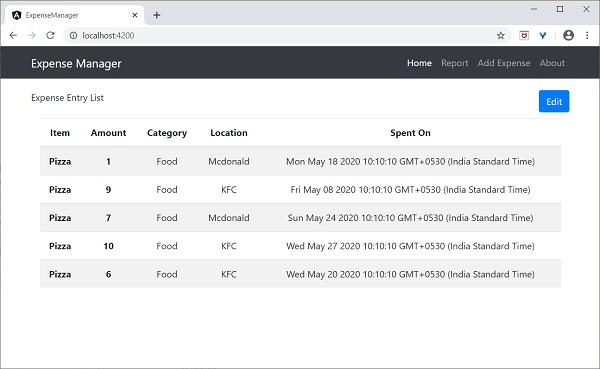
- Angular 8 教程
- Angular 8 - 首頁
- Angular 8 - 簡介
- Angular 8 - 安裝
- 建立第一個應用程式
- Angular 8 - 架構
- Angular 元件和模板
- Angular 8 - 資料繫結
- Angular 8 - 指令
- Angular 8 - 管道
- Angular 8 - 響應式程式設計
- 服務和依賴注入
- Angular 8 - Http 客戶端程式設計
- Angular 8 - Angular Material
- 路由和導航
- Angular 8 - 動畫
- Angular 8 - 表單
- Angular 8 - 表單驗證
- 身份驗證和授權
- Angular 8 - Web Workers
- Service Workers 和 PWA
- Angular 8 - 伺服器端渲染
- Angular 8 - 國際化 (i18n)
- Angular 8 - 可訪問性
- Angular 8 - CLI 命令
- Angular 8 - 測試
- Angular 8 - Ivy 編譯器
- Angular 8 - 使用 Bazel 構建
- Angular 8 - 向後相容性
- Angular 8 - 工作示例
- Angular 9 - 新特性?
- Angular 8 有用資源
- Angular 8 - 快速指南
- Angular 8 - 有用資源
- Angular 8 - 討論
Angular 8 - 指令
Angular 8 指令是與應用程式互動的 DOM 元素。通常,指令是一個TypeScript函式。當此函式執行時,Angular編譯器會在 DOM 元素內檢查它。Angular 指令以ng-開頭,其中ng代表 Angular,並使用@directive裝飾器擴充套件 HTML 標籤。
指令允許將邏輯包含在 Angular 模板中。Angular 指令可以分為三類,如下所示:
屬性指令
用於為現有 HTML 元素新增新屬性,以更改其外觀和行為。
<HTMLTag [attrDirective]='value' />
例如:
<p [showToolTip]='Tips' />
這裡,showToolTip 指的是一個示例指令,當它用於 HTML 元素時,會在使用者懸停 HTML 元素時顯示提示。
結構指令
用於在當前 HTML 文件中新增或刪除 DOM 元素。
<HTMLTag [structuralDirective]='value' />
例如:
<div *ngIf="isNeeded"> Only render if the *isNeeded* value has true value. </div>
這裡,ngIf 是一個內建指令,用於在當前 HTML 文件中新增或刪除 HTML 元素。Angular 提供了許多內建指令,我們將在後面的章節中學習。
基於元件的指令
元件可以用作指令。每個元件都有Input和Output選項,用於在元件及其父 HTML 元素之間傳遞資料。
<component-selector-name [input-reference]="input-value"> ... </component-selector-name>
例如:
<list-item [items]="fruits"> ... </list-item>
這裡,list-item 是一個元件,items 是輸入選項。我們將在後面的章節中學習如何建立元件和高階用法。
在進入本主題之前,讓我們在 Angular 8 中建立一個示例應用程式(directive-app)來鞏固所學知識。
開啟命令提示符,使用以下命令建立一個新的 Angular 應用程式:
cd /go/to/workspace ng new directive-app cd directive-app
使用 Angular CLI 建立一個test元件,如下所示:
ng generate component test
以上命令建立一個新的元件,輸出如下:
CREATE src/app/test/test.component.scss (0 bytes) CREATE src/app/test/test.component.html (19 bytes) CREATE src/app/test/test.component.spec.ts (614 bytes) CREATE src/app/test/test.component.ts (262 bytes) UPDATE src/app/app.module.ts (545 bytes)
使用以下命令執行應用程式:
ng serve
DOM 概述
讓我們簡要了解一下 DOM 模型。DOM 用於定義訪問文件的標準。通常,HTML DOM 模型被構建為物件的樹。它是一個訪問 html 元素的標準物件模型。
我們可以在 Angular 8 中出於以下原因使用 DOM 模型:
- 我們可以輕鬆地使用 DOM 元素導航文件結構。
- 我們可以輕鬆地新增 html 元素。
- 我們可以輕鬆地更新元素及其內容。
結構指令
結構指令透過新增或刪除元素來更改DOM的結構。它用 * 符號表示,並具有三個預定義指令NgIf、NgFor和NgSwitch。讓我們逐一簡要了解一下。
NgIf 指令
NgIf 指令用於根據條件為真或假來顯示或隱藏應用程式中的資料。我們可以將其新增到模板中的任何標籤。
讓我們在我們的directive-app應用程式中嘗試ngIf指令。
在test.component.html中新增以下標籤。
<p>test works!</p> <div *ngIf="true">Display data</div>
在你的app.component.html檔案中新增測試元件,如下所示:
<app-test></app-test>
使用以下命令啟動你的伺服器(如果尚未啟動):
ng serve
現在,執行你的應用程式,你將看到以下響應:
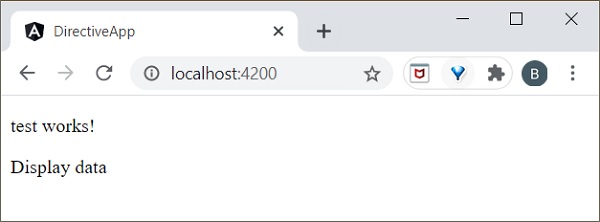
如果將條件設定為ngIf=“false”,則內容將被隱藏。
ngIfElse 指令
ngIfElse類似於ngIf,不同之處在於它還提供了在失敗情況下渲染內容的選項。
讓我們透過一個示例瞭解ngIfElse的工作原理。
在test.component.ts檔案中新增以下程式碼。
export class TestComponent implements OnInit {
isLogIn : boolean = false;
isLogOut : boolean = true;
}
在test.component.html檔案中新增以下程式碼:
<p>ngIfElse example!</p> <div *ngIf="isLogIn; else isLogOut"> Hello you are logged in </div> <ng-template #isLogOut> You're logged out.. </ng-template>
最後,使用以下命令啟動你的應用程式(如果尚未啟動):
ng serve
現在,執行你的應用程式,你將看到以下響應:
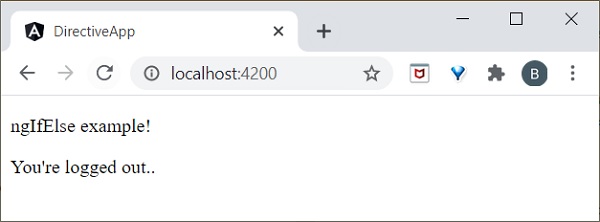
這裡:
isLogOut
值為true,因此它進入else塊並渲染ng-template。我們將在本章後面學習ng-template。ngFor 指令
ngFor 用於重複專案列表中的部分元素。
讓我們透過一個示例瞭解 ngFor 的工作原理。
在 test.component.ts 檔案中新增如下所示的列表:
list = [1,2,3,4,5];
在test.component.html中新增ngFor指令,如下所示:
<h2>ngFor directive</h2>
<ul>
<li *ngFor="let l of list">
{{l}}
</li>
</ul>
這裡,let 關鍵字建立一個區域性變數,它可以在模板中的任何位置引用。let l 建立一個模板區域性變數來獲取列表元素。
最後,使用以下命令啟動你的應用程式(如果尚未啟動):
ng serve
現在,執行你的應用程式,你將看到以下響應:
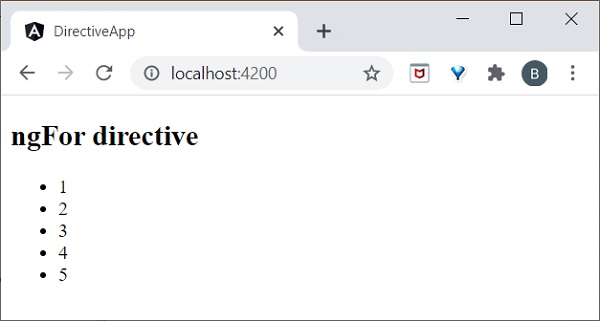
trackBy
有時,對於大型列表,ngFor的效能較低。例如,當在列表中新增新專案或刪除任何專案時,可能會觸發多個 DOM 操作。要迭代大型物件集合,我們使用trackBy。
它用於跟蹤何時新增或刪除元素。它由 trackBy 方法執行。它有兩個引數:index 和 element。Index 用於唯一標識每個元素。簡單的示例定義如下。
讓我們透過一個示例瞭解 trackBy 與ngFor一起工作的方式。
在test.component.ts檔案中新增以下程式碼。
export class TestComponent {
studentArr: any[] = [ {
"id": 1,
"name": "student1"
},
{
"id": 2,
"name": "student2"
},
{
"id": 3, "name": "student3"
},
{
"id": 4,
"name": "student4"
}
];
trackByData(index:number, studentArr:any): number {
return studentArr.id;
}
這裡:
我們建立了:
trackByData()
方法以基於 id 的唯一方式訪問每個學生元素。在test.component.html檔案中新增以下程式碼,以便在 ngFor 中定義 trackBy 方法。
<ul>
<li *ngFor="let std of studentArr; trackBy: trackByData">
{{std.name}}
</li>
</ul>
最後,使用以下命令啟動你的應用程式(如果尚未啟動):
ng serve
現在,執行你的應用程式,你將看到以下響應:
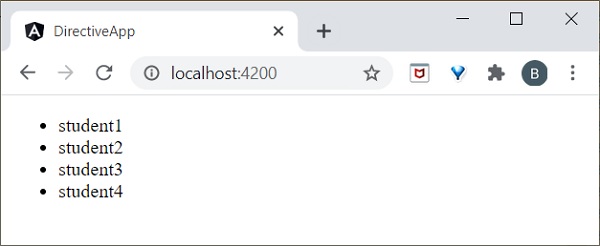
這裡,應用程式將列印學生姓名。現在,應用程式使用學生 ID 而不是物件引用來跟蹤學生物件。因此,DOM 元素不會受到影響。
NgSwitch 指令
NgSWitch用於檢查多個條件,並使 DOM 結構保持簡單易懂。
讓我們在我們的directive-app應用程式中嘗試ngSwitch指令。
在test.component.ts檔案中新增以下程式碼。
export class TestComponent implements OnInit {
logInName = 'admin';
}
在 test.component.html 檔案中新增以下程式碼:
<h2>ngSwitch directive</h2>
<ul [ngSwitch]="logInName">
<li *ngSwitchCase="'user'">
<p>User is logged in..</p>
</li>
<li *ngSwitchCase="'admin'">
<p>admin is logged in</p>
</li>
<li *ngSwitchDefault>
<p>Please choose login name</p>
</li>
</ul>
最後,使用以下命令啟動你的應用程式(如果尚未啟動):
ng serve
現在,執行你的應用程式,你將看到以下響應:
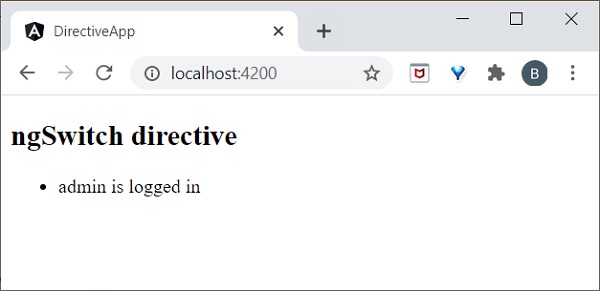
這裡,我們定義了logInName為admin。因此,它匹配第二個 SwitchCase 並列印上面與 admin 相關的訊息。
屬性指令
屬性指令執行 DOM 元素或元件的外觀或行為。一些示例包括 NgStyle、NgClass 和 NgModel。而 NgModel 是在上一章中解釋的雙向屬性資料繫結。
ngStyle
ngStyle指令用於新增動態樣式。以下示例用於將藍色應用於段落。
讓我們在我們的directive-app應用程式中嘗試ngStyle指令。
在test.component.html檔案中新增以下內容。
<p [ngStyle]="{'color': 'blue', 'font-size': '14px'}">
paragraph style is applied using ngStyle
</p>
使用以下命令啟動你的應用程式(如果尚未啟動):
ng serve
現在,執行你的應用程式,你將看到以下響應:

ngClass
ngClass用於在 HTML 元素中新增或刪除 CSS 類。
讓我們在我們的directive-app應用程式中嘗試ngClass指令。
使用以下命令建立一個類User
ng g class User
你將看到以下響應:
CREATE src/app/user.spec.ts (146 bytes) CREATE src/app/user.ts (22 bytes)
轉到src/app/user.ts檔案並新增以下程式碼:
export class User {
userId : number; userName : string;
}
這裡,我們在User類中建立了兩個屬性userId和userName。
開啟test.component.ts檔案並新增以下更改:
import { User } from '../user';
export class TestComponent implements OnInit {
users: User[] = [
{
"userId": 1,
"userName": 'User1'
},
{
"userId": 2,
"userName": 'User2'
},
];
}
這裡,我們聲明瞭一個區域性變數 users 並用 2 個使用者物件初始化它。
開啟test.component.css檔案並新增以下程式碼
.highlight {
color: red;
}
開啟你的test.component.html檔案並新增以下程式碼:
<div class="container">
<br/>
<div *ngFor="let user of users" [ngClass]="{
'highlight':user.userName === 'User1'
}">
{{ user.userName }}
</div>
</div>
這裡:
我們應用了ngClass到User1,因此它將突出顯示User1。
最後,使用以下命令啟動你的應用程式(如果尚未啟動):
ng serve
現在,執行你的應用程式,你將看到以下響應:
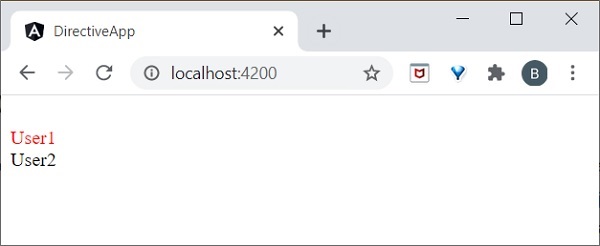
自定義指令
Angular 提供了使用使用者定義的指令擴充套件 angular 指令的選項,這稱為自定義指令。讓我們在本節中學習如何建立自定義指令。
讓我們嘗試在我們的directive-app應用程式中建立自定義指令。
Angular CLI 提供以下命令來建立自定義指令。
ng generate directive customstyle
執行此命令後,你將看到以下響應:
CREATE src/app/customstyle.directive.spec.ts (244 bytes) CREATE src/app/customstyle.directive.ts (151 bytes) UPDATE src/app/app.module.ts (1115 bytes)
開啟app.module.ts。指令將透過declarations元資料在AppModule中配置。
import { CustomstyleDirective } from './customstyle.directive';
@NgModule({
declarations: [
AppComponent,
TestComponent,
CustomstyleDirective
]
})
開啟customstyle.directive.ts檔案並新增以下程式碼:
import { Directive, ElementRef } from '@angular/core';
@Directive({
selector: '[appCustomstyle]'
})
export class CustomstyleDirective {
constructor(el: ElementRef) {
el.nativeElement.style.fontSize = '24px';
}
}
這裡,constructor方法使用CustomStyleDirective獲取元素作為el。然後,它訪問 el 的樣式並使用 CSS 屬性將其字型大小設定為24px。
最後,使用以下命令啟動你的應用程式(如果尚未啟動):
ng serve
現在,執行你的應用程式,你將看到以下響應:
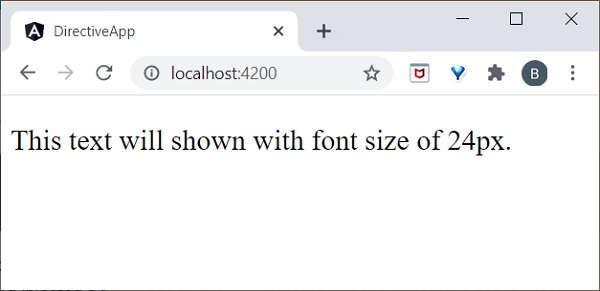
ng-template
ng-template用於建立動態且可重用的模板。它是一個虛擬元素。如果你使用ng-template編譯程式碼,則它會在 DOM 中轉換為註釋。
例如:
讓我們在test.component.html頁面中新增以下程式碼。
<h3>ng-template</h3> <ng-template>ng-template tag is a virtual element</ng-template>
如果你執行應用程式,它將只打印h3元素。檢查你的頁面原始碼,模板顯示在註釋部分,因為它是一個虛擬元素,所以它不會呈現任何內容。我們需要將ng-template與 Angular 指令一起使用。
通常,指令會發出與其關聯的 HTML 標籤。有時,我們不需要標籤,只需要內容。例如,在下面的示例中,將發出 li。
<li *ngFor="let item in list">{{ item }}</li>
我們可以使用ng-template安全地跳過li標籤。
ng-template 與結構指令
ng-template應始終用於ngIf、ngFor或ngSwitch指令內部以呈現結果。
讓我們假設一個簡單的程式碼。
<ng-template [ngIf]=true> <div><h2>ng-template works!</h2></div> </ng-template>
這裡,如果ngIf條件為真,它將列印 div 元素內的資訊。類似地,你也可以使用ngFor和ngSwitch指令。
NgForOf 指令
ngForOf 也是一個結構指令,用於渲染集合中的專案。下面的示例用於演示ng-template 內部的 ngForOf 指令。
import { Component, OnInit } from '@angular/core';
@Component({
selector: 'app-test',
template: `
<div>
<ng-template ngFor let-item [ngForOf]="Fruits" let-i="index">
<p>{{i}}</p>
</ng-template>
</div>`
,
styleUrls: ['./test.component.css']
})
export class TestComponent implements OnInit {
Fruits = ["mango","apple","orange","grapes"];
ngOnInit()
{
}
}
如果執行應用程式,它將顯示每個元素的索引,如下所示:
0 1 2 3
元件指令
元件指令基於元件。實際上,每個元件都可以用作指令。元件提供 @Input 和 @Output 裝飾器,用於在父元件和子元件之間傳送和接收資訊。
讓我們嘗試在我們的 directive-app 應用程式中使用元件作為指令。
使用以下命令建立一個新的 ChildComponent:
ng generate component child CREATE src/app/child/child.component.html (20 bytes) CREATE src/app/child/child.component.spec.ts (621 bytes) CREATE src/app/child/child.component.ts (265 bytes) CREATE src/app/child/child.component.css (0 bytes) UPDATE src/app/app.module.ts (466 bytes)
開啟 child.component.ts 並新增以下程式碼:
@Input() userName: string;
在這裡,我們為 ChildComponent 設定一個輸入屬性。
開啟 child.component.html 並新增以下程式碼:
<p>child works!</p>
<p>Hi {{ userName }}</p>
在這裡,我們使用 userName 值來歡迎使用者。
開啟 test.component.ts 並新增以下程式碼:
name: string = 'Peter';
開啟 test.component.html 並新增以下程式碼:
<h1>Test component</h1> <app-child [userName]="name"><app-child>
在這裡,我們使用 AppComponent 作為帶有輸入屬性的指令在 TestComponent 內。
最後,使用以下命令啟動你的應用程式(如果尚未啟動):
ng serve
現在,執行你的應用程式,你將看到以下響應:
[](images/directive-app/component_as_directive.PNG)
工作示例
讓我們在我們的 ExpenseManager 應用程式中新增一個新元件來列出支出條目。
開啟命令提示符並轉到專案根資料夾。
cd /go/to/expense-manager
啟動應用程式。
ng serve
使用以下命令建立一個新的元件 ExpenseEntryListComponent:
ng generate component ExpenseEntryList
輸出
輸出如下:
CREATE src/app/expense-entry-list/expense-entry-list.component.html (33 bytes) CREATE src/app/expense-entry-list/expense-entry-list.component.spec.ts (700 bytes) CREATE src/app/expense-entry-list/expense-entry-list.component.ts (315 bytes) CREATE src/app/expense-entry-list/expense-entry-list.component.css (0 bytes) UPDATE src/app/app.module.ts (548 bytes)
在這裡,該命令建立了 ExpenseEntryList 元件並在 AppModule 中更新了必要的程式碼。
將 ExpenseEntry 匯入到 ExpenseEntryListComponent 元件中 (src/app/expense-entry-list/expense-entry-list.component)
import { ExpenseEntry } from '../expense-entry';
新增一個方法 getExpenseEntries() 以在 ExpenseEntryListComponent (src/app/expense-entry-list/expense-entry-list.component) 中返回支出條目的列表(模擬專案)。
getExpenseEntries() : ExpenseEntry[] {
let mockExpenseEntries : ExpenseEntry[] = [
{ id: 1,
item: "Pizza",
amount: Math.floor((Math.random() * 10) + 1),
category: "Food",
location: "Mcdonald",
spendOn: new Date(2020, 4, Math.floor((Math.random() * 30) + 1), 10, 10, 10),
createdOn: new Date(2020, 4, Math.floor((Math.random() * 30) + 1), 10, 10, 10) },
{ id: 1,
item: "Pizza",
amount: Math.floor((Math.random() * 10) + 1),
category: "Food",
location: "KFC",
spendOn: new Date(2020, 4, Math.floor((Math.random() * 30) + 1), 10, 10, 10),
createdOn: new Date(2020, 4, Math.floor((Math.random() * 30) + 1), 10, 10, 10) },
{ id: 1,
item: "Pizza",
amount: Math.floor((Math.random() * 10) + 1),
category: "Food",
location: "Mcdonald",
spendOn: new Date(2020, 4, Math.floor((Math.random() * 30) + 1), 10, 10, 10),
createdOn: new Date(2020, 4, Math.floor((Math.random() * 30) + 1), 10, 10, 10) },
{ id: 1,
item: "Pizza",
amount: Math.floor((Math.random() * 10) + 1),
category: "Food",
location: "KFC",
spendOn: new Date(2020, 4, Math.floor((Math.random() * 30) + 1), 10, 10, 10),
createdOn: new Date(2020, 4, Math.floor((Math.random() * 30) + 1), 10, 10, 10) },
{ id: 1,
item: "Pizza",
amount: Math.floor((Math.random() * 10) + 1),
category: "Food",
location: "KFC",
spendOn: new Date(2020, 4, Math.floor((Math.random() * 30) + 1), 10, 10, 10),
createdOn: new Date(2020, 4, Math.floor((Math.random() * 30) + 1), 10, 10, 10)
},
];
return mockExpenseEntries;
}
宣告一個區域性變數 expenseEntries 並載入如下所示的模擬支出條目列表:
title: string;
expenseEntries: ExpenseEntry[];
constructor() { }
ngOnInit() {
this.title = "Expense Entry List";
this.expenseEntries = this.getExpenseEntries();
}
開啟模板檔案 (src/app/expense-entry-list/expense-entry-list.component.html) 並以表格形式顯示模擬條目。
<!-- Page Content -->
<div class="container">
<div class="row">
<div class="col-lg-12 text-center" style="padding-top: 20px;">
<div class="container" style="padding-left: 0px; padding-right: 0px;">
<div class="row">
<div class="col-sm" style="text-align: left;">
{{ title }}
</div>
<div class="col-sm" style="text-align: right;">
<button type="button" class="btn btn-primary">Edit</button>
</div>
</div>
</div>
<div class="container box" style="margin-top: 10px;">
<table class="table table-striped">
<thead>
<tr>
<th>Item</th>
<th>Amount</th>
<th>Category</th>
<th>Location</th>
<th>Spent On</th>
</tr>
</thead>
<tbody>
<tr *ngFor="let entry of expenseEntries">
<th scope="row">{{ entry.item }}</th>
<th>{{ entry.amount }}</th>
<td>{{ entry.category }}</td>
<td>{{ entry.location }}</td>
<td>{{ entry.spendOn | date: 'short' }}</td>
</tr>
</tbody>
</table>
</div>
</div>
</div>
</div>
這裡:
使用了 Bootstrap 表格。table 和 table-striped 將根據 Bootstrap 樣式標準設定表格樣式。
使用 ngFor 遍歷 expenseEntries 並生成表格行。
開啟 AppComponent 模板 src/app/app.component.html 幷包含 ExpenseEntryListComponent 並刪除 ExpenseEntryComponent,如下所示:
... <app-expense-entry-list></app-expense-entry-list>
最後,應用程式的輸出如下所示。
